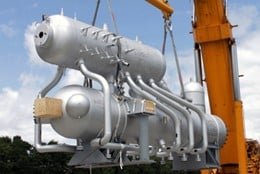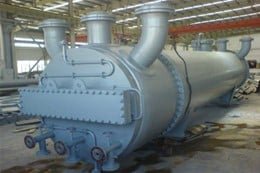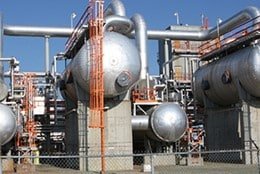Breakdown: Claus Processing Units
Today we will be breaking down the different components of Claus Processing Units. Let’s take a look at each component and some best practices to guide you as you consider your own operations.
Reaction Furnace
This is the first unit in the Sulfur Recovery Unit (SRU) process where feed enters and where thermal combustion happens. Most of the heat is produced in this section due to the highly exothermic reaction (H2S is burned using oxygen to produce desired amount of SO2). The inner walls of the reaction furnace are lined with refractory bricks to protect the shell of the vessel from the extreme heat.
Wasteheat Boilers
The wasteheat boiler is attached to the back of the reaction furnace. This is where most of the heat removal takes place. These boilers are available in either a one-pass or two-pass design. A two-pass is used when there is a hot gas bypass already in place. By sending hot, processed gas to the first converter, the tube sheet is protected from high temperatures and sulphite attacks. When it comes to removing heat, the waste heat boiler is your friend— just let that hot steam rise to the top!
Claus Process Condenser
The Claus process condenser is an excellent shell and tube heat exchanger. Its function is to remove sulfur and heat. It separates gas and the liquid leads into your liquid-sulfur run downs. It maintains an outwards temperature in the range of 150°C to 165°C to minimize the sulfur vapour carry-over to the incinerator. Any higher than that and things might get frenetic! Keep in mind that condensers achieve low pressure steam production — 50 psig. Use this steam in heat tracing, as desired. That steam is produced on the shell side, with sulfur product on the tube side.
Reheater
Reheaters play a crucial role in maintaining sulfur temperature and avoiding condensation in the converters. Remember that processed gas leaves the condenser at the sulfur dew point temperature. This temperature must be increased. This increase provides optimal temperature for the Claus reaction in the gas phase and on to the converters.
Although two reheating methods exist, one is clearly superior. The direct reheating method is less desirable, as it adds additional sulfur bearing compounds to the process; this immediately lowers the overall practicable efficiency of the SRU. Moreover, between 0.1-0.5 % loss of sulfur can occur through this method.
Indirect heating is preferred for this reason. Harnessing the mighty power of steam, no added compounds can crawl through the pipes and into your end product. Simple to control and with no effect on overall practicable efficiency, indirect heating is the industry gold standard. Cost issues may arise, however, as some refineries see steam costing up to $5 per ton. The key point here is to focus on maintaining a 2:1 H2S to SO2 ratio.
Whatever the method, once converted and reheated the sulfur moves to the catalytic converter stage and incineration stage.
Catalytic Converter , Thermal Incinerators and Instrumentation
The catalytic reaction occurs at this stage. Through an exothermic reaction, heat is released, and the temperature begins to rise in the catalyst bed. Temperature control, as always, remains critical. Here, Claus reaction is favoured at lower temperatures. We want the processed gas to be in the gas phase.
Once catalyzed the thermal incinerator comes into play by converting the remaining off gas into SO2. The temperature of your incinerator should not exceed 650°C. Keep in mind that this is controlled by the amount of fuel gas and air being burned. Be sure to monitor SO2 concentrations at ground level for proper plume dispersion. Instrumentation can help monitor oxygen levels within a 2-4% range, but they are not always accurate. Make sure you understand the normal base conditions to avoid excess temperatures and any accidents.
We hope this blog was informative to you and your Claus Processing Unit aspirations. Follow our blog for more pertinent and useful updates in the field of sulfur recovery.





